Our Savior’s Episcopal Church is the only church in El Dorado County that has been in continuous use as a house of worship since its construction. The cornerstone was laid on June 22, 1865, just two months after the end of the Civil War, and the church was opened to the public on December 23, 1865. It has remained open ever since.
The church is Neo-Gothic Revival, a favorite style for churches built in the Mother Lode from 1850 to 1890. The architect has a real understanding of the Gothic elements that were used in the original Gothic cathedrals in Europe, but did not have European materials available to create the Gothic effect, so he used local wood.
He used the wood to make a light and elegant vaulted roof. The shape of the vaulted roof was created using scissor trusses with a long top cord. By doing this, he created the shape of a vaulted roof, and to ensure a continuous roof appearance, he placed the trusses at three feet on center. To support the trusses, a second wall was built right inside the outer wall, giving the tall windows the appearance of openings in a thick stone wall. The trusses are brought together at the top to form a four-layer vaulted roof over the Sanctuary.
As far as we understand, this type of roof structure has only been used in churches in the United States in New England and the California Mother Lode.
William Patton, architect, was an authority on the architecture of the Anglican Church and a leading architect of his time in California.
Patton was born in England in 1821 and trained in architecture. He sailed around the Horn to San Francisco in the early days of the gold rush and spent several years in the Mother Lode, after which he moved to San Francisco, where he opened an architectural office.
Patton designed many prominent buildings in Alameda and San Francisco, including parts of San Francisco City Hall, of which he was the architect. He moved to San Francisco by the time he designed the Church of Our Savior.
